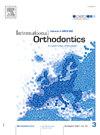Mandibular symphysis dimensions among various craniofacial patterns: A systematic review and meta-analysis
IF 1.9
Q2 DENTISTRY, ORAL SURGERY & MEDICINE
引用次数: 0
Abstract
Objectives
To evaluate and synthesize the available evidence on mandibular symphysis dimensions across different sagittal and vertical craniofacial skeletal patterns.
Methods
Eligibility criteria: cross sectional studies comparing mandibular symphysis dimensions among individuals with different sagittal and vertical skeletal patterns. Information sources: unrestricted literature search of six databases (PubMed, Scopus, Web of Science, LILACs, Cochrane and Google Scholar) was conducted up to April 2025 without language restriction. Risk of bias: the quality assessment of the included studies was conducted using Joanna Briggs Institute tool. Synthesis of results: random-effects meta-analyses were performed using mean differences (MDs) and 95% confidence intervals (CIs). Heterogeneity was assessed using I2 and Tau2 statistics. Subgroup analyses were conducted based on ethnicity, imaging modality, and risk of bias. Publication bias was evaluated.
Results
Included studies: twenty-three cross-sectional studies involving 3313 participants (40.35% male) were included. Synthesis of results: class III subjects showed significantly greater symphysis area (MD = 2.37[1.33, 3.41]), height (MD = 0.75[0.27, 1.22]), and convexity (MD = 3.59[0.69, 6.49]) compared to Class I. Hyperdivergent individuals had increased symphysis height (MD = 1.31[0.53, 2.1]) and reduced width (MD = –1.25[–2.37,–0.12]), while hypodivergent individuals showed reduced height (MD = –0.68[–1.34,–0.03]) and increased width (MD = 1.42[0.41, 2.42]). Subgroup analyses revealed ethnicity and risk of bias as significant modifiers, particularly in Class II and vertical pattern comparisons. No significant publication bias was detected.
Discussion
Limitations of evidence: the inclusion of mostly retrospective studies, presence of growing individuals, inadequate control for confounders, inconsistent age and sex reporting, and limited outcome data restricted the strength and scope of the meta-analysis. Interpretation: symphysis dimensions vary by skeletal pattern, with vertical growth type showing stronger associations than sagittal class.
Registration
PROPSERO (CRD420251049382).
不同颅面形态的下颌联合尺寸:系统回顾和荟萃分析
目的评价和综合不同矢状面和垂直面颅骨形态下下颌联合尺寸的现有证据。方法:采用横断面研究比较不同矢状和垂直骨型个体的下颌联合尺寸。信息来源:截至2025年4月,对PubMed、Scopus、Web of Science、LILACs、Cochrane和谷歌Scholar六个数据库进行无限制文献检索,无语言限制。偏倚风险:采用Joanna Briggs Institute工具对纳入研究进行质量评估。结果综合:随机效应荟萃分析采用平均差异(md)和95%置信区间(ci)进行。采用I2和Tau2统计量评估异质性。亚组分析基于种族、成像方式和偏倚风险。评价发表偏倚。结果纳入研究:纳入23项横断面研究,涉及3313名受试者(40.35%为男性)。综合结果:III类受试者联合面积(MD = 2.37[1.33, 3.41])、高度(MD = 0.75[0.27, 1.22])和凸度(MD = 3.59[0.69, 6.49])明显大于i类受试者。高发散个体联合高度(MD = 1.31[0.53, 2.1])增加,联合宽度(MD = -1.25[-2.37, -0.12])减小,低发散个体联合高度(MD = -0.68[-1.34, -0.03])降低,联合宽度(MD = 1.42[0.41, 2.42])增加。亚组分析显示,种族和偏倚风险是重要的修饰因素,特别是在II类和垂直模式比较中。未发现显著的发表偏倚。证据的局限性:纳入的大多是回顾性研究,个体的增长,对混杂因素的控制不足,年龄和性别报告不一致,有限的结果数据限制了meta分析的强度和范围。解释:联合的尺寸因骨骼类型而异,垂直生长类型比矢状生长类型有更强的相关性。RegistrationPROPSERO (CRD420251049382)。
本文章由计算机程序翻译,如有差异,请以英文原文为准。
求助全文
约1分钟内获得全文
求助全文
来源期刊

International Orthodontics
DENTISTRY, ORAL SURGERY & MEDICINE-
CiteScore
2.50
自引率
13.30%
发文量
71
审稿时长
26 days
期刊介绍:
Une revue de référence dans le domaine de orthodontie et des disciplines frontières Your reference in dentofacial orthopedics International Orthodontics adresse aux orthodontistes, aux dentistes, aux stomatologistes, aux chirurgiens maxillo-faciaux et aux plasticiens de la face, ainsi quà leurs assistant(e)s. International Orthodontics is addressed to orthodontists, dentists, stomatologists, maxillofacial surgeons and facial plastic surgeons, as well as their assistants.
 求助内容:
求助内容: 应助结果提醒方式:
应助结果提醒方式:


